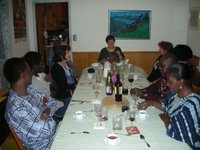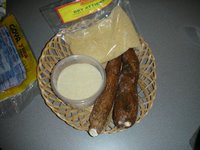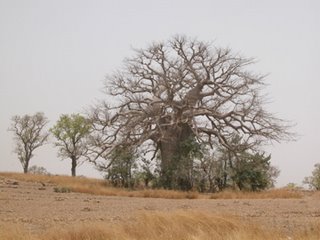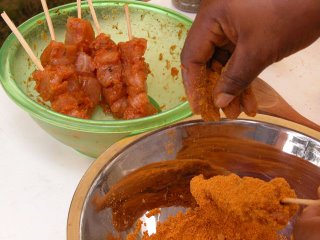
Here are some thoughts on Question #4: Isn't African food too. . . ? insert preferred negative term (e.g., hot/bland/primitive/boring/tough/oily/, etc.)
There's a profound yet simple proverb about ethnocentrism in many African societies (e.g., the Baganda, Akamba, Kikuyu, Bemba, Haya, Igbo, and Yoruba). Translated, it means "
The one who has not traveled widely thinks his/her mother is the best cook."This proverb often comes to mind when I hear Americans talking about African food, especially Sub-Saharan African food, in a patronizing, superior way, and also lumping a whole continent together in a way they would never dream of doing for other global locations. A missionary in Ghana once sniffed and said to me disparagingly "They eat grass," when referring to the greens cooked in stews. In Pennsylvania we carefully distinguish among varieties of apples (Rome, Gala, Granny Smith, Red or Golden Delicious, Macintosh, Pink Lady, Ginger Gold, Braeburn, Crispin, Cameo, etc., etc.). In Ghana that discrimination applies to greens, of which it's documented that people savor 47 different kinds. Just because our palates haven't been trained to detect the textures, degrees of bitterness, saltiness, etc. doesn't mean that the food is inferior.
Similarly, people often say that Africans eat some kind of starch, but they lump them all together, without detecting the differences among, say, types of yams, rice, plantains, millets, sorghum, corn, sweet potatoes, potatoes, cassava, taro (cocoyams), even wheat, along with very different methods of preparation (fermented, unfermented, pounded, dried, fresh, boiled, fried, roasted, steamed, stirred, etc.).
Also, some tastes are acquired, as I found living in Japan and learning to eat bean paste, raw seafood, and miso soup--but once acquired these foods are treasured. And just because, as
Marcus Samuelsson (celebrity chef/author and owner of 3 New York restaurants) laments, people don't know what
piri piri,
thieboudienne, or
mafé are, doesn't mean the food is somehow unpalatable, just that our culinary literacy needs upgrading.
It is true that some African food is spicy hot from a variety of (originally New World) chili peppers. So is some Chinese food, or some Mexican food, but that does not mean it's somehow "bad." In fact, many people prize the foods for that very quality. Also, many African foods have nonspicy options (e.g., Ethiopian
alichas [
alechas] mild stews, rather than
wats [
watts,
we'ts], which are spicy stews). Some people in Ghana "cannot take pepper" and so always have their food prepared without it. In other parts of the continent, such as inland in some East African countries, the foods are much blander, but it may be that people there savor the pure flavor of vegetables and oils used in cooking.
Cindy Bertelsen from the delightful food history blog
Gherkins & Tomatoes just sent me the link to a
NY Times article ("In Epicurian New York, the Challenge of Africa") from July 2008 on African cuisine's cool reception in New York City. (NOTE: you may need to have a free account to access this article.) The article reminds me of assumptions many people make about the continent's cuisine. First, that "You think of sub-Saharan Africa stereotypically as the continent of scarcity," says Prof. Ray of NYU. Let's also add to the list of negative things about "African food" the words "tough, tough meat." “One of the things that may put American diners off West African restaurants is that Africans vastly prefer tough, tough meat,” said Robert Sietsema, restaurant critic for The Village Voice. Yeah, that'll get you excited about trying sub-Saharan African food. I again remembered the words of Alan Dundes, my college anthropology professor that "We fail to see the lens through which we look." In France, a snail (
escargot) is
haute cuisine, but in Africa they are likely "so tough you would have difficulty distinguishing (them) from a section of rubber tire" (Sietsema). The spongy, crepe-like pancake made of teff in Ethiopia is simply described (in the same article) as "rubbery."
Grains of paradise or melegueta pepper, a spice once a fashionable substitute for black pepper in the 1300 and 1500s in Europe, and related to cardamom and ginger, is called "pungent," not a particularly flattering description.
Sietsema also suggests that “For
them (my bolding) eating something for dinner is not an appreciation of tenderness. It is an appreciation of toughness, and they want to really chew on the meat and enjoy it because meat is so rare.” I'm not sure where he got that explanation, and the article says nothing about the fish and seafood and poultry and vegetables that many people consume far more often than meat. Certainly, free range chickens are tougher (and more flavorful) than the fryers in our supermarkets. My nephews from Ghana refuse to eat American fryer chickens because they're so soft and mushy. I agree with them. As for "tough, tough" meat--no upscale African restaurant in the U.S. is likely to give something like that to Americans.
The quote I mentioned in my last posting mentioned Rozin's dismissal of Sub-Saharan Africa's cuisines as "neither rich nor complex" (
Ethnic Cuisine, 1983). She includes a cursory consideration of only 2 recipes for the almost 50 countries that make up the area. The disparity in her book with representation of other cuisines is quite conspicuous and consistent with my findings when I looked at "Sub-Saharan African Cuisine and Western Perceptions" (see slides at link at
betumi.com)
. I was dismayed when I read Jack Goody's book years ago
Cooking, Cuisine and Class to see that his whole book was written to answer the question "Why are traditional African cultures largely lacking a differentiated cuisine?" He came up with an impressive argument, basically the reasons that societies in China and the West had very different hierarchies and specialization related to food, concluding essentially that there was a "high" cuisine for those, and a "low" cuisine for African societies (never mind that he also also warns at the beginning of the book against "placing societies in simplistic binary categories.") I found it difficult to articulate what exactly bothered me about the book, except that I sensed he had a superior attitude (at one point I seem to remember him saying that if a chief needed more help in his kitchen, he simply married another wife, and my thinking that not all women are equal in the kitchen, and maybe he married a skilled chef). Finally, I wonder at the preference for the elaborate over simplicity.
Let me briefly mention oil. It is true that many West Africans (especially Nigerians!) love to have a lot of oil in the soups/stews, especially red palm oil. This is something that really goes against the grain of Westerners, and we are quick to note that the "big man" or woman in many West African countries is indeed just that. We also forget that bigness is often a prized stature in these countries. Only the wealthy and powerful can get fat! It is important to remember that historically most people in Africa were not able to afford lots of oil in the food, except on special occasions. Oil (like being "fat") is often seen to be a symbol of prosperity and generosity and hospitality and respect and nurturing. Also, oil is a highly concentrated form of energy, useful in societies where farmers and others do hard physical labor. We've been taught to believe that "palm oil" (shudder, shudder) is very unhealthy and saturated. It's true that a little goes a long way (as is true of butter or cream, but we seem to ignore that), but as I mention in my article in
Gastronomica "We Eat First With Our Eyes: On Ghanaian Cuisine"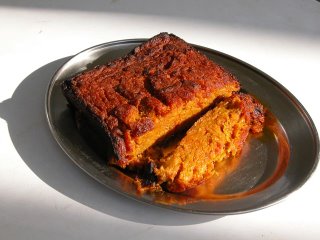
we often confuse palm kernel oil with palm fruit oil, neglect to consider palm oil may be refined or unrefined, and that there are multiple qualities, just as there are with olive oils.
Health issues and African cuisine will be covered in Question #7, but if one considers obese Americans stuffing down hamburgers and French fries and chips and drinking super-sized soft drinks, or the pastries and mega-size sugared drinks being consumed in coffee shops, one has to wonder about the claims of superiority of our very differentiated "high cuisine" Western diet.
Is a society that may prefer fresh fruit to sugared cakes, cookies, and pastries really that "low"?
Labels: Bertelsen, Jack Goody, Rozin, Samuelsson, Sietsema
 I'm back from 2 weeks of graduations, being with family and friends, tasting Jamaica, and generally being treated like a queen. There is much to catch up on, beginning with a few words about the panel on "Interdisciplinary Perspectives on African Cuisines" held on May 30th at Penn State and the small dinner party afterwards. The panel went well (despite being scheduled for 8 a.m.
I'm back from 2 weeks of graduations, being with family and friends, tasting Jamaica, and generally being treated like a queen. There is much to catch up on, beginning with a few words about the panel on "Interdisciplinary Perspectives on African Cuisines" held on May 30th at Penn State and the small dinner party afterwards. The panel went well (despite being scheduled for 8 a.m. http://gherkinstomatoes.com/2009/06/06/10572/ (pumpkins). Igor
http://gherkinstomatoes.com/2009/06/06/10572/ (pumpkins). Igor Cusack followed up with a discussion of cookbooks and national identity in Africa. Through what seemed incredible indifference and inefficiency on the part of the U.S. Embassy in Yaounde, Forka Leypey Mathew Fomine was unable to receive a visa in time to attend the conference, so I (Fran Osseo-Asare)
Cusack followed up with a discussion of cookbooks and national identity in Africa. Through what seemed incredible indifference and inefficiency on the part of the U.S. Embassy in Yaounde, Forka Leypey Mathew Fomine was unable to receive a visa in time to attend the conference, so I (Fran Osseo-Asare) contact me if you wish to obtain an electronic copy of his fascinating paper. I then made some observations of my own about the cassava "saga" in Africa, and the transformation of cassava from an orphan crop to a nurturing "mother," and an important emerging cash crop in West Africa. Culinary historian Michael Twitty rounded out the
contact me if you wish to obtain an electronic copy of his fascinating paper. I then made some observations of my own about the cassava "saga" in Africa, and the transformation of cassava from an orphan crop to a nurturing "mother," and an important emerging cash crop in West Africa. Culinary historian Michael Twitty rounded out the  session with a look at ethnic culinary variation in West African links and contributions to American Southern cooking. There was some lively discussion, and the general consensus was that there is a huge need for more of these kinds of opportunities to focus on African cuisines. I would
session with a look at ethnic culinary variation in West African links and contributions to American Southern cooking. There was some lively discussion, and the general consensus was that there is a huge need for more of these kinds of opportunities to focus on African cuisines. I would frustration that Saturday morning was "so much to say, so little time!"
frustration that Saturday morning was "so much to say, so little time!"